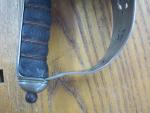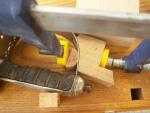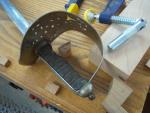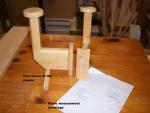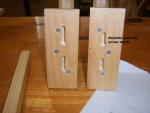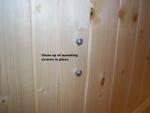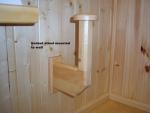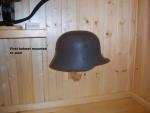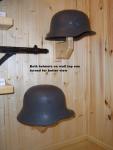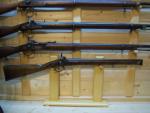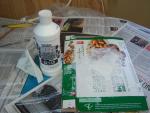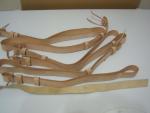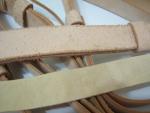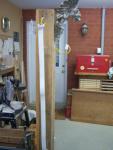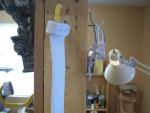-
Posts
6,486 -
Joined
-
Last visited
-
Days Won
10
Content Type
Profiles
Forums
Blogs
Gallery
Events
Store
Everything posted by Brian Wolfe
-

Myth Busting - Part 1
Brian Wolfe commented on Brian Wolfe's blog entry in News From the Home Office.
Hi Paul, Thanks for your comments. I was contemplating touching on “financing” certain additions to a collection and then thought that I may end up sounding like I was contradicting what I had earlier said about not collecting “on the card”. If an item comes up and the only way you can obtain this rarely offered specimen then the only option may be to “finance” it. This doesn’t mean put the cost on the credit card and then at month’s end, when the amount comes due, pay the minimum and continue adding more “once in a life time” finds. I had (emphasis on the word “had”) a friend who tapped out his Visa purely by collecting and making payments through the card. His answer, once it was maxed out, was to get a Master Card; and so started the cycle all over again. I have made larger purchases on the credit card, from time to time, and then paid it off before the amount came due, thereby saving the interest, which can be quite high. I remember when a “loan” at 20% was illegal and called “usury”. Now it has been legalized because a bank is doing it. Ethically it’s still usury; the difference is that now it is legalized theft. A less expensive option may be to actually take out a bank loan which carries a lot lower interest rate. Remember I am talking about a true “once in a life time” find; not simply the current find that would have been available at a later date; albeit from a different source. Once in a life time is exactly that, a figuratively “never” offered piece; in that case go for it. Regards Brian -
Myth Busting, Part 1 I do hope no one will feel like I am being condescending with the way I have written this blog. My intention was to treat the reader like a fellow GMIC member and therefore more like a friend than a stranger. With this in mind treat the following in the manner in which it is intended and that is as a conversation between friends. Myth Busters, a popular television program takes popular myths and “puts them to the test” and awards a rating of “Confirmed”, “Plausible” or “Busted”. The show often concludes with something from the episode being blown to oblivion. This is NOT one of those blogs. We are prohibited from the use of explosive devices here in cyberspace as the resulting shock wave may cause damage to sensitive computer components. Besides, you know if we started with lower grade controlled explosives it would only be a matter of time when someone from here at the Home Office would ramp it up to a thermo nuclear device and the magnetic pulse would undo all of Nick’s hard work getting the new server up and running smoothly. What I thought we’d take a look at is some of the commonly or uncommonly held beliefs, or myths, in the fields of collecting and within history itself. Let’s start with collecting and specifically the myth that collecting anything, short of precious metals, is an investment. First let me state that I am not economist or investment banker and my opinions are based on a good number of years of experience and observation. Further, unlike many who will wax prophetic, I base my observations and resulting conclusions not on my mistakes in life but mainly on a few successes. That should be somewhat of a refreshing change from, “don’t do what I’ve done”, (break into the music and lyrics from “The House of the Rising Sun”), to here’s what I found works and the mistakes of others. Collecting, and we will stick to militaria, should only involve disposable income. Disposable income is the money you have left over after all the bills are paid and an appropriate amount has been invested (at least 10% of your income) into non-collectables investments. For most people the concept of personal disposable income is more myth than reality. If you have a mortgage, or more than one, or if you owe money for a vehicle or two, and after the bills are paid you have little to no money left over I can pretty well tell you that you DO NOT (yes I am shouting here) you DO NOT have disposable income. If you are working two or more jobs to make ends meet... you may have guessed it...you don’t have true disposable income. Working yourself to death just so you can collect is a whole new set of problems – seek help. The credit card is not a form of disposable income either and certainly should never be used to finance a collection. I’ve often read or even heard first hand that a person is collecting as an investment. An investment? Perhaps that person should look up the definition of an investment. The last time I checked our investment portfolio and spoke with our investments banker there were no options for investing in collectables. Hmm, should that perhaps be telling us something? It’s a little like the myth of the ninja; if there had been ninjas as portrayed in films and books wouldn’t there be authentic ninja swords being offered for sale. Ninja swords NOT made in China that is. The clues are there just look for them...oh yes; they’re ninjas so I suppose their artifacts would also be invisible. I knew I should have used zombies as an example! It is a really a stupid thing to tell your wife that the purchase of the latest sword, firearm or medal etc. is a good investment. She’s really not that dumb, or at least there will be a day of awakening when she realizes that the so called investment won’t bring in much more the 25 cents on the dollar of “investment”. Think I’m mistaken? Seriously, speak with an established dealer and see what he or she is willing to pay for your collection. You will be most unpleasantly surprised; likely as not the offer will fall between 15 to 20 cents on the dollar. That doesn’t mean you will realize $1.20 for every dollar “invested” but rather 20 cents, period. I recently sold a geological collection that took fifty years to amass, though I have not been seriously collecting for the past decade. I offered it to a dealer at 25 cents on the dollar and at first he was hesitant, until he actually viewed what I had. He usually pays the 15 to 20 cents on the dollar for collections but much of my collection was no longer available on the market due to many countries deeming the specimens as national treasures. They are illegal to collect at the source now but previously collected specimens may be bought and sold. I did manage to break even on some of the specimens I collected decades ago but for the most part I let them go “cheaply”. Could I have sold them one piece at a time and realized more in the long run? Sure, however, considering it took three trips with his van, packed floor to ceiling and wall to wall, in order to ship them to his warehouse, I would have to live to be 175 years old in order to sell the collection off piece meal. Most large militaria collections fall under the same category. I’ve heard of collectors claiming to keep their collection in a safety deposit box in the bank due to the value. Ok, so you have purchased, as a source of investment, and rather than enjoying the collection it is hidden away in the bank. What do you have, $20,000 tucked away in the bank vault, on which you need to pay a fee? So in the end you might realize $4,000 to $5.000 dollars in total when you sell? If that was going to put your child through university, I think little “bonzo” will be out looking for a job to foot the costs of schooling. Here’s a tip. Let the kid work his (or her) way through university; this will accomplish a couple of things. It will keep them focused on the goal and not on the parties. Plus they will have a better chance of a useful degree rather than a Masters in Norse Mythology and Interpretive Ancient Babylonian Folk Dancing if they are working to pay for their own education. Yep, I’m a cold hearted bastard. Here’s a thought. Once the last child has graduated you can give them all cheques for the amount of their initial student loan, provided you can afford it, and haven’t “invested” in cornering the market on WWI Polish Victory Medals. I hope that those reading this blog are indeed in a position that they have their youth and have true disposable income now. It took me a long time and a lot of work. I also hope that you are collecting because it makes you happy and you have kept the investing myths out of the hobby. Next time I won’t be so preachy and we’ll discuss some of the myths attached to history and the artifacts themselves. Happy collecting. Regards Brian
-

MG 15 Saddle Drum magazines and carriier
Brian Wolfe replied to Gordon Craig's topic in Firearms & Ordnance
Hi Gordon, Very nice and from what I have been told quite rare to find them with the carrier. At a show near here I saw one on a dealer's table. I don't think it was a nice as yous, and during the conversation that was being held between the dealer and a possible buyer it was said that the carrier is harder to find than the drums. I suppose this makes a lot of sense considering in the case of those in carriers it would be a 3 to 1 ratio. Thanks for posting this interesting and rare item, it is greatly appreciated. Regards Brian -
A great find and the additional history together with the sabre makes this an exceptionally informative and interesting post. I tend to think the last Spanish sabre issued was a far better sword than either the British or the American issues as far as being a good all all around sword. Regards Brian
-
Some very nice truncheons to be sure. As always you have not simply stopped that the "look at this" stage and added some excellent information regarding replicas. You may have saved some members (me included) from making a very expensive mistake in purchasing one of the Indian copies as an authetic specimen. When we are at militarial shows it is sometimes hard to look at a specimen and relize that something is wrong. The image of a British police officer holding one of these out at arm's length, as identification, should stick in our heads for future reference. Many thanks Mervyn. Regards Brian
-

Truncheons, Nightsticks, Billy Clubs and "Cudgels"
Brian Wolfe replied to speagle's topic in Police Forces of the World
Never write off the Canadians as being kind and gentle, that's just what we want you to think. Back in the 1960s they used these "Zaps" as well as a small truncheon that comprised of a flexable metal spring-like shaft with a larger handle with a weighted cylindar afixed to the tip. The whole thing was covered in heavy black leather. The OPP used to carry these in their back pockets with a leather loop hanging out for quick retrienal. These were about 7 or 8 inches in length. I suspect they stopped using them as they could be real skull crushers. Regards Brian -
When I decided to move my office downstairs to a room next to the collection room I thought I had the space problem solved for years to come by using the office for part of the collection as well. After unpacking the stored items I find myself in need of more room and it has only been four months! We are all doomed I tell you...DOOMED! Regards Brian
-

Truncheons, Nightsticks, Billy Clubs and "Cudgels"
Brian Wolfe replied to speagle's topic in Police Forces of the World
-

Winston Churchill - Desert Warrior
Brian Wolfe commented on Brian Wolfe's blog entry in News From the Home Office.
On the contrary Les, I welcome both the additional inforamtion and the clairification. To be honest it is input such as yours that makes the work of putting together a blog such as this one a worth while endevor. Regards Brian -

Winston Churchill - Desert Warrior
Brian Wolfe commented on Brian Wolfe's blog entry in News From the Home Office.
Thank you for your kind comments Mervyn, they are both appreciated and encouraging. Regards Brian -
Hi Gordon, An interesting weapon and one well worth adding to any collection. The right mounted clip is indeed unique and I have often wondered why this was done. My collection of sub machine guns are all mounted facing to the right so my Stens have to be displayed without the mag in the weapons. Thanks for posting this interesting and historic arm. Regards Brian
-
Winston Churchill, Desert Warrior Part Four: The North African Campaign. There was so little time to rejoice at his appointment as Prime Minister on 10 May, 1940 with that same day being the fall of France to the Germans, a month later on 10 June Italy declaring war on Britain followed by the Battle of Britain on10 July. It must have seemed that the world was celebrating his appointment by promptly falling apart; it makes one wonder if Churchill was starting the dread the 10th of each month. Unlike so many other politicians of his day and especially those of our modern era Churchill was not simply a man of rhetoric but a man of action, more than capable of cashing the cheques his mouth had written in the pre-war era. At times his hubris may have led him to make decisions that would later be condemned by his critics but the time for hesitation was over. I am reminded of the old saying that it is better to light one candle than to curse the darkness. Hitler was to find out, in time, that Churchill was the man to light that candle and when he did it was with a flame thrower. I covered the Battle of Britain in last month’s entry of this series even though chronologically the North Africa Campaign started a full month earlier. This was done in an attempt to avoid appearing as if we were jumping around from one place to another and giving the story a bit better flow albeit at the risk of anachronism. In earlier installments of this series we talked about Churchill’s fear of creating a static war like that of the Great War by attacking the Germans head to head somewhere in Europe. To use the word “fear” when speaking of Winston Churchill is unfair and, I believe, quite inaccurate. To decide that driving up a mountain road in winter may be too dangerous then waiting until spring, taking a safer route to achieve the same goal is not the action of a coward but the actions of a sane and calculating person. Churchill would later write of his feelings during the war as his only true fear was that of the U-boat menace. Churchill much preferred the re-invasion of Norway over the direct confrontation in Europe and held onto this argument even as the preparations of D-day were being prepared. Of all the campaigns of the War perhaps the actions in the deserts of North Africa brought into the spot light of history the most notable and near-mythic personalities of the century. The names, Alexander, Auchinleck, Eisenhower, Patton, Rommel and Kesselring, to name just a few, would become household words from one end of the glob to another. The North Africa Campaign would perhaps be the beginning of Churchill being seen as one of the many rather than the main player in the war. The declaration of war by Italy upon both France and Britain was not any great surprise considering her alliance with Germany and the German declaration or war. This was not the first aggressive act by Italy against a target in Africa as they had attacked Abyssinia (Ethiopia) on 3 October 1935. If you recall, earlier in this series, the League of Nations did nothing to assist Abyssinia and by May of 1936 Italy had virtually defeated the forces of Abyssinia and Emperor Haile Selassie went into exile, living at Fairfield House in Bath, England. He returned to the capital, Addis Ababa, as Emperor on 5 May, 1941 after the withdrawal of the Italian forces from Abyssinia. Churchill was facing a great deal of pressure from the Soviets to undertake a second front in Europe at this time; a proposition that Churchill did not favour as we have made mention numerous times. He preferred smaller confrontations that brought much needed victories to bolster the British peoples’ resolve. Time and time again he fought against a second front in France, even after the entry of America into the war. His arguments ranged from not having enough landing craft to the lack of training of the allied troops in attacking a well defended “Fortress Europe”. Statistics show that there was more than enough landing craft in England at this time to support an invasion. While the argument of the allied troops being unprepared may be debatable the fact that by D-Day the German defences were much stronger is an undeniable reality. Churchill’s reluctance to launch an invasion against the Germans in Europe held D-day up for at least a year. One cannot but speculate the additional cost in life this hesitation cost the allies. In the resent past, here in the West, historians would have us think that Britain was alone against Germany at this time. I have somewhat even suggested this earlier in this series. The fact is that Britain had a potentially very powerful ally in the form of the Soviet Union. Churchill distrusted the Soviets and was in no hurry to commit troops to a second front, which did nothing to endure the West to Stalin. One of the tactics Churchill did support whole heartedly was the use of the SOE (Special Operations Executive) in clandestine raids within Europe. His idea was, to use his words, “set Europe ablaze”. Churchill was a proponent of learning from history and drew his ideas from his time spend fighting the Boers in South Africa. He noted the success of the Boer commando raids and wanted to employ the same tactics in Europe to disrupt the Germans and deny as much materials of war as possible through sabotage. While these operations did achieve in bringing in valuable intelligence as well as causing a good deal of mayhem critics have pointed out that the cost in lives through German reprisals was appalling. One of the greatest examples of the costs of these operations is the assignation of SS-Obergruppenfuhrer Reinhardt Heydrich on 27 May 1942 by Czech SOE operatives. The assignation resulted in the extermination of 192 men, 50 women and 88 children from the Czech town of Lidice. Even given the balance sheets of war one has to ask whether the removal of one high ranking Nazi official was worth the cost; our generation is fortunate to have the luxury of such debates. Another criticism of the SOE was that it kept competent military leaders from leading their troops in the field due to their preoccupation with sabotage. While the above two examples may be fuel for debate as they are based on personal observation and conclusions the one cold hard fact is that not one of the sixty-six German divisions stationed in France on D-Day was committed to internal security. [John Keegan, Churchill (London: Weidenfeld and Nicoloson), 2002 pg. 128]. Keegan goes on to state that things in Southern Europe were much worse. “Greece and Yugoslavia were ravaged by reprisals and by the civil wars that resistance provoked ...The consequences of encouraging resistance in Yugoslavia and Greece were socially and politically disastrous; they persist to this day.” [Ibid.] Another discussion that was directly linked to the North Africa Campaign was the disastrous Dieppe raid, 19 August 1942. For over half a century the facts about the raid on Dieppe were kept from the public. Speculation as to the purpose ranged from the reasonable to the realm of those who find conspiracy in everything from the cause of the death of Tutankhamen to the truth about the Moon Landing. Resent evidence has shown that this was a “pinch raid”, that is to say a raid to steal something, in this case the German Enigma machine. The British had been making some progress in breaking the enemy code when the Germans decided to add an additional rotor wheel which made all of the work by British decoders nearly useless. Captured intelligence revealed that the German U-boats were poised to enter into the Mediterranean. Rommel was about to begin his second offensive (21 January 1942) and the threat of the U-boats was considerable to the supply of the Allied troops in North Africa. While the raid was unsuccessful it would seem that the true nature of the “pinch raid” was as unclear to the Germans as it was to the British and Canadians who took part in it; at least this allowed the British code breakers to continue on deciphering the Enigma machine, working in secret. We are getting ahead of the story so we’ll back up a bit. The war in North Africa went quite well for the British troops and the Italians soon found that taking on the British Empire was going to be no where as easy as their Abyssinian Campaign of 1935. The North Africa Campaign started on 10 June 1940 and nine months later, by 7 February 1941, what was left of the Italian 10th Army had surrendered. Churchill favoured smaller campaigns that would return positive results and, as we have discussed, took the attention away from a landing on the European continent. Campaigns, even successful ones, all have one thing in common; men and materiel wear out and need replacing. Even though this was not taking place the British were on the verge of victory. A victory in North Africa at this time would have prevented the commander of the newly formed German Afrika Korps, Lieutenant-General Erwin Rommel, from even landing. Unfortunately Churchill snatched defeat from the jaws of victory by his next tactical decision based on political obligation to Greece. Italy and Greece were at war with one another since Italy invaded Greece on 28 October 1940. At first the Greek Army held the Italians at bay; that is until Italy requested assistance from her ally Germany. Churchill has been criticized for his decision of 9 February, 1941, to pull experienced troops out of North Africa in order to strengthen the Greek defence of their country from the combined forces of Italy and Germany. This decision greatly weakened the British presence in North Africa and while the men transferred to Greece were replaced by fresh troops, these new troops were not battle hardened such as were the men they were replacing. This decision on the part of Churchill, despite his generals’ protests, not only allowed the Italians to receive much needed reinforcements set the victory in North Africa back by two years; with the loss of countless more lives. In addition to this the number of troops transferred to the Greek conflict was insufficient to prevent the inevitable defeat of Greece and then Crete. Was this an unforgivable blunder on the part of Churchill, or was there more to the decision than whim, which seems to be the suggestion by many historians less supportive of Churchill than this author. What is conveniently overlooked by Churchill’s critics is the Declaration of 1939 that in the event of a threat to the independence of Greece or Romania that the British would take all actions possible to come to their defence. It must be remembered that at this time America was being “romanced” by Churchill to enter the war on the allied side. Even though it was a moral decision that had to be made to defend Romania and Greece it would not have bode well in the view of the United States had Britain simply turned her back on these allies in need. It may have also led the public to believe that Britain had returned to the Chamberlain era of looking only to her own immediate needs (the avoidance of another war) at the expense of those with whom she had claimed alliance. The failure of Italy to take Greece in a timely manner and the need for German intervention may have had far reaching consequences in the German plans for the invasion of Russia. Hitler blamed the failure of Operation Barbarossa on the delays for that campaign due to Italy’s failure to conquer Greece without the aid of German troops. [Kershaw, Ian, 2007, Fateful Choices: Ten Decisions that Changed the World 1940-1941, pg. 178] With Greece and Romania now firmly in German hands one would assume the writing on the wall of history would be a portent of doom for the British in North Africa. However like most graffiti on any wall promising, “For a good time call Betty”, often proves erroneous, history would once again record that famous Churchillian luck that I am so fond of mentioning. Code breaking of the German transmissions had experienced a breakthrough and now the Allies could monitor the movements of supply transport in the Mediterranean. It has been estimated that up to 60% of Axis shipping was destroyed due to the breaking of their code. [Kingsly, Sir Harry “The Influence of ULTRA in the Second World War”] To make things worse for the Germans the Allies, under the command of General Eisenhower, landed in Morocco and Algeria on 8 November 1942. This opened up what the Germans have been taught to be avoided at all costs, a second front. The lack of supply, the strengthened allied forces, new materiel plus the requirement of fighting on two fronts spelled doom for the Afrika Korps and victory for the allies, and Churchill, of course. It should be mentioned that as of 22 June 1941 (almost a year and a half before the fall of North Africa) German military planning had turned its attention from North Africa to Russia. I think we need to take a minute to look at the decision by Hitler to commence operation Barbarossa even though history books point out that his generals advised against it, much as Churchill’s generals advised against the British involvement in Greece at the possible expense of North Africa. Churchill based his decision on ethics, but what about Hitler and his decision to invade Russia and open up that dreaded second front. Part of the problem stems for history written just after the Second World War where any suggestion to the contrary regarding Hitler being a megalomaniac, a raving monster incapable of making sound decisions was frowned upon. This would be much like making a statement, soon after 911, that the attack on the World Trade Centre involved incredible planning and co-ordination. This type of statement, no matter how little actual praise was intended toward the instigators would be met with distain by a shocked and disillusioned public; much as is any suggestion of intellect being involved in the decision to invade Russia in 1941. In 1940 a war broke out between Finland and the Soviet Union called the Winter War (a subject for a later article) in which it appeared that small Finland had held out against the Goliath, Russia. While basically true in the beginning the exploits of the Finnish military certainly were partially a matter of myth generated by the media and the free world’s need to believe it was so. The free world was not the only ones watching what was unfolding in Finland; Hitler was also following this conflict with great interest. He came to the conclusion that Russia was so ill prepared that a small well armed, trained and dedicated army could stop the Russian juggernaut in its tracks. If Finland could do this then Russia had no chance against Germany’s war machine. [Speer, Albert, Inside the Third Reich, New York, 1970, pg. 169] While it was true that Hitler’s generals advised against a second front and cited Napoleon’s mistake, however, they were basing their advice on information that was 130 years old while Hitler was basing his decisions on information (albeit erroneous) that was most current. It wasn’t just Hitler who noticed the Finnish/Soviet war of 1940; Joseph Stalin also showed interest in it and the reasons his troops faired so poorly, at least at the onset of the war. His analysis of the conflict led him to revamp the strategy and reporting structure of the Red Army. Lessons from the Winter War may have attributed to later Soviet successes that assured their victories from Stalingrad to Berlin. Now with North Africa in Allied hands Churchill convinced the political and military leaders to invade Sicily and then Italy, the “soft under belly of Europe”. The one thing I quickly found out as a young man interviewing Italian Campaign veterans, for my own interest, was that you never mentioned the “soft under belly of Europe” to them, lest you were assaulted with a long lecture filled with colourful and abusive metaphors. The implications of that phrase was, to the veterans’ point of view, that the Italian Campaign was something much easier than it actually was. This is the last installment in this series on Winston Churchill and I do hope that I presented his story during these troubled times in a fair manner. It is my opinion that the Italian Campaign, D-Day Invasion, the Conquest of Europe and the Japanese conflict are all too large to deal with within an article about one particular leader. I also feel that from the onset of WWII until the entrance of the Americans the war was mainly a British and Commonwealth show with Winston Churchill at the forefront of events. After North Africa it became an international affair with Britain, the United States and the Soviet Union all making decisions rather than everything being in the hands on one leader. Summary: We’ve taken a look at the man, Winston Churchill, and his decisions from the years leading up to the Second World War and through to the North African Campaign and made mention of his less than successful Balkans Campaign of World War One. All in all I find it difficult to hang the blame entirely on Churchill for the Gallipoli disaster simply because a decision was made and executed, then found lacking. This is a matter of record. Also a matter of record is that the British and colonial Generals and leaders involved continued with the campaign for an additional eight months after Churchill was removed from his position of Lord of the Admiralty. Some blame must be attributed to those who continued with the disaster once it had been deemed that success was impossible. True, Churchill was the First Lord of the Admiralty during the plan to “force the Straights” of the Dardanelles, however the plan was devised by Churchill AND Kitchener. This was to be a naval action as no land forces were available for a landing. The attack on 15 February, 1915 failed, as we all know. As to the landings at Gallipoli are concerned, the plan was devised by General Sir Ivan Hamilton and Vice Admiral Sir John de’Robeck in March, 1915 and approved by Kitchener. Churchill offered his support. It should be noted that no one in authority objected to this plan. It could very well be argued that Churchill was in favour of the plan based the approval by that military genius, Kitchener. To criticize Churchill for making decisions of a military nature against the advice of his generals then turn around and criticize him when he did take their advice, albeit a mistake, shows a certain degree of obscurantism on the part of his critics. We’ve read where Churchill’s actions actually delayed the D-Day invasion at least for a year. The result being that the Germans were better prepared by the time of the invasion than they would have been a year earlier. Well, to that I would say, “Bravo for perfect hindsight’, which is a wonderful tool for criticising those who had an impossible job to do in a world gone mad. In the interpretation of history we need to be mindful not to fall into the trap of “presentism”; that is to say looking at events from the past through the eyes of the present and judging those events by today’s values and concepts. We can lay blame for the bombing of German cities, for whatever purpose, on “Bomber” Harris or Winston Churchill. However, true to western propaganda, we are left with the impression that Britain was completely alone at the beginning of the war; which is not completely true. The first bombing raid on Berlin by the British was 25 August 1940; however by 8 August 1941 the Soviet Union had also joined in the bombing of Berlin. Regardless of one’s opinion of the bombing of German cities it was not Britain alone involved in these attacks. As many veterans have reminded me, “It was war!” The one point I would like to leave you with is this. After the fall of France and in spite of many of the British public and political leaders, who were suggesting capitulation, it was Winton Churchill who rallied England to stand and fight. Had Hitler not been stopped at the English Channel what was to be the combined military might of the British, her Commonwealth and the United States would not have had the staging point provided by the United Kingdom to launch the D-Day invasion. With no second front to worry him Hitler would have been free to attack Russia with the full might of the German armed forces. The prospect of such a scenario is most sobering indeed. Churchill stopped Hitler at the channel and that fact alone may have saved the world. Thank you for bearing with me over the past few months and thank you for all of your constructive comments, they are always greatly appreciated. Regards Brian
-
It looks like ER to me. I held up my Geo V specimen as a compairison against the x-ray of yours and noticed there seems to be neither a "V" or "VI" for one of the King Georges and there would appear to be an "E" in the scroll. From the photo it looks like the King's crown which seems odd to me. I hope others, perhaps with better eyesight, will comment. Regards Brian
-

Sword Guard Repairs
Brian Wolfe replied to Brian Wolfe's topic in Preservation & Restoration of Military Artifacts
Actually those are some of the drones we have developed. We offered them to the U.S. Government for trials in the Middle East but they were not all that successful. I suppose making then all look like either a Canada Goose of a Northern Loon may have been a slinght error. Back to the drawing board. Brian -

Sword Guard Repairs
Brian Wolfe replied to Brian Wolfe's topic in Preservation & Restoration of Military Artifacts
The sword has never seen combat as it has never been sharpened even though it is a Geo.V era sword. These had the bumb-bell shaped blade and only the last 4 inches would have been sharpened but this one was not and was no doubt used for dress parads etc. This type of damage is common to mis-handling by either the owner's heirs or a careless dealer. Due to the weight of the sword if it is held by the scabbard upside down and is bumped the guard can be damaged if it strikes something hard. This type of damage is not what you would normally find if used in battle, that and the short time swords were still used during the First World War makes this likely damage through carelessness. Hmm, I never thought of you being put up to your harassment by my wife. You are now on the "watch list" and I'll assign a staffer for the Home Office to monitor your communications. Unlike your FBI we enjoy immunity from prosecution for unapproved surveillance, mainly because we are so secret we don't exist...or do we. Regards Brian -
Repairing a Sword Guard When I am running the shop I like to have several projects on the go at one time when possible. Many times I find myself with all of the projects that absolutely must be completed as soon as possible in a stage where everything is “in clamps†waiting for the glue to set up. It is during these “down times†that I will tackle some repairs to the items that need it from the collection. Today I am showing how I repaired the bent hand guard on a pattern 1895 Infantry Officer’s Sword. A common injury to swords stored in their scabbards often occurs when the sword is moved from place to place by people unfamiliar with edged weapons. The sword is either carried or passed to another person with the grip downward allowing it to slip from the scabbard and bending the guard upon striking a hard object, usually near the narrow part of the guard near the grip. The first photo shows the damage. While not drastic it does distract from the overall appearance of the sword and should be repaired. The first thing you will need to do is to determine the proper curvature of the guard in its undamaged state. Once you have done this take a hardwood block and cut that curve so you have something close as possible to the correct shape to bend the guard to. You will also need a large hardwood dowel cut in half which will be used to force the guard into the curved piece. As you can see in the photos below you will need to cut the hardwood block, in this case white oak, so that the clamp you will be using isn’t going to slip off the block when you start to tighten it down. Set the hardwood dowel aside for now. Use a screw clamp and not one of the quick-clamps you may have seen in some of my other “how-to†posts because you need lots of pressure to bend the metal and quick-clamps will not do as good a job (and they “kill†your wrists when trying to squeeze them hard enough). The jaws of the clamp should have protectors on them to prevent damage to the sword guard. This will bring the guard close to the correct shape. Next re-clamp using the ½ dowel which will bring the metal further into the curvature of the hardwood block. Note that the sword will have to be secured to the table of workbench as in this case. I was able to use the bench dogs or vise clamp pins to secure the sword handle in place. My “dogs†are made of red oak and will not scratch the sword, do not use steel dogs...for anything...ever. If you can’t find wooden bench dogs then make your own; you’ll thank me later. Most people will not have a workbench and may only have a work table so you can use blocks clamped to the table to hold the sword as well. You’ll notice I’ve also used a large block clamped to the bench at the back of the sword in the photo that serves to hold the sword in place. Tighten the clamp again using the wooden ½ dowel as shown to bring the guard to its correct shape. You should now be finished and your guard should also be back to near original condition, or as original as you can get it. If it needs further “bending†you will have to cut the curve of the hardwood block a bit deeper and using the ½ dowel bend the guard using the clamp and see if that is enough. I was happy with the way mine turned out and I hope you will try some repairs of your own as it greatly increases the overall appearance, the collectability of the item and with it the value. Happy restorations. Brian
-

DIY Helmet Stand - Tutorial
Brian Wolfe replied to Brian Wolfe's topic in Preservation & Restoration of Military Artifacts
Wall rack – helmet After noticing that the helmet stands I featured above were much like many other such stands on the internet I wanted to make something a little different. Upon looking around the collection room I had the realization that most of us either fill up our wall space or our counter top display first. I must admit that I have little space left on either the walls nor the counter top display areas. That aside, there is usually room in one of the two areas that have not yet been occupied. I have put together two wall mounted helmet stands which might be of interest. They are made of pine and held together by glued dowels, with the exception of the wall mounting bracket which is held on with long screws. I used long screws to install a wall mounting plate which had two “keyhole†slots using a router bit cut in the back for the screws. These fit over screws in the wall affixing the stand without any visible means of attachment. I really like using this method as it not only looks neat it can also keep the uninitiated guessing as to how you achieved the mount without screws; or at least looking like you didn’t use screws. You may wonder why I didn’t simply use the router on the horizontal piece that holds the helmet stand column to the wall. Because of the way the grain runs any use of this method would not be strong enough and the weight of the helmet might just tear the screw heads through the stand support. http://gmic.co.uk/uploads/monthly_02_2015/post-1801-0-26381700-1424805558.jpg I won’t go through a lot of description of the stand’s construction other than to say I glued up thinner boards; using two ¾ inch pieces to make 1½ inch thick stock. I may have gone a bit too heavy and any other wall mount stands I might attempt will be constructed using thinner stock. The great thing about the round top that the helmet rests on is that you can turn the helmet to allow for the best view. I have done this as the helmets in my display are close to the corner and I wanted their profiles to show as well as possible. http://gmic.co.uk/uploads/monthly_02_2015/post-1801-0-78931600-1424805628.jpg I hope you like my latest shop project and will try this yourself sometime. If you have any questions please feel free to leave it in a reply to this post or contact me directly through email or a PM. Regards Brian -
There is something unfinished about any long firearm such as a musket or modern rifle that is without its sling. To me it is not properly “dressedâ€. Many of the muskets and even rifles and their accompanying kit of the British Empire were white. Many times these were coated with what was known as Blanco and therefore the finished kit and even including the Wolseley-style helmets were said to have been Blancoed. A search of my small area of the world revealed that the product know as “Blanco†was unavailable; so what to use. Further reading suggested that I try what is called “Gesso†an acrylic compound that artists use when preparing their canvas to accept the paint they will be using. So it was off the art store in a neighbouring city with the faint hope of finding Gesso. I say “faint hope†as I have found that trying to locate some much needed materials here in my part of Ontario quite often ends in disappointment. The young lady at the art store was very helpful and if I were fifty years younger... Who am I trying to kid, I would have left with the Gesso after having been too scared to strike up a conversation with the young lady. Even at sixteen I was constantly engaged in such projects, which as my wife likes to point out, is why I have no friends from my youth. Original nerd! http://gmic.co.uk/uploads/monthly_02_2015/post-1801-0-84725900-1424544261.jpg Quite a while ago I had several leather slings custom made in England for my muskets and black powder carbines. I say “custom made†only in the sense that I had contacted a gentleman who produces these slings and asked that he make mine “inside outâ€. That is to say with the rough unfinished leather on the outside and the smooth side inside. I could have simply used smooth sided slings and turned them around but the fastening rivets would have also been the wrong way around. There is a section of an old possibly original sling shown with the newly made slings so you might get an idea of how older slings look after several decades. Gesso is a thick liquid not unlike acrylic paints used in art work, so in a sense I suppose this is actually an acrylic white paint used as a base coat on canvas. At first I thought to use a small tin can to hold the Gesso but soon found out that applying a “gob†onto a piece of cardboard, much in the manner of a artist using a paint pallet worked best. I use a lot of disposable brushes in the shop and decided to try one of these in my first attempt; first big mistake. The Gesso is thick and while disposable brushes work well when applying pre-stain and then stain to a piece of furniture I found the black bristles tended to pull out of the brush at an alarming rate. Since I also found that the water cleanup worked very well on the brush the second sling was painted using a good quality brush. The second big mistake was not taking the sling apart. I thought to coat all of the areas I could get at and any areas under the leather loops could be done at a later time after the first coat had dried. Not only did the Gesso tend to stick all of the moving parts together the areas where the Gesso had not been applied presented a problem that in hindsight I should have anticipated. The second coat left the formally untreated areas quite visible, so a third coat was necessary to blend everything together. The second sling was disassembled and even the first coat was a vast improvement over the first experiment. A second coat may not have been absolutely necessary but a second coat was applied anyway. I should mention that Gesso is non-chalking and by that I mean it will not rub off onto the musket or your clothing once it is dry. I purchased a couple of Martini Henrys a number of years ago (since sold) that had slings that were coated with liquid white shoe polish. This did “chalk†and where the sling touched the stock a white mark had been left. If you rubbed your hand over the sling the white chalk-like residue came off. I would never recommend the use of liquid white shoe polish on any piece of military kit, unless you know of one that will not leave a chalky residue. I am fortunate to have a shop where I can do just about any project that my humble talents will allow. In the shop I have a drying pole (see photos) where smaller projects that would not dry well on a bench are suspended. The pole, especially with the gargoyle at its top, probably looks like something that would be better suited to a medieval torture chamber but take my word for it this is indispensable when working with smaller projects. http://gmic.co.uk/uploads/monthly_02_2015/post-1801-0-44926800-1424544362.jpg http://gmic.co.uk/uploads/monthly_02_2015/post-1801-0-07514600-1424544385.jpg If you want to attempt this but lack areas in which to work you can put down some news papers on the kitchen table, coat the sling and suspend it, using some coat hanger wire, from your shower curtain rod. Gesso is thick and it dries very quickly therefore there is no problems with it dripping onto the floor or bathtub. Being water clean-up any accidents you might have can be cleaned up quickly and easily (before your wife returns from shopping). I would suggest wearing latex gloves when working with Gesso or any liquid finish even though they may be water soluble. Any colouring tends to get under your fingernails or in the creases of your hands so gloves are a good idea. You will find that the Gesso has made the sling slides harder to “slide†and the installation is somewhat of an ordeal. Be patient and keep working the sling strap through the slide loops, it will eventually go where you want it. If you find that the musket or rifle sling loops were not as clean as you thought them to be and this has left some dirt or grease on the sling I would not get too concerned. I don’t like additions like a sling looking like it just came from the factory as it doesn’t match the weapon, most of the time. A little grime simply ages the sling and makes it look more authentic. There are aging tricks you can do to make your sling look absolutely “period†but that is something that would be better left for another post at a later date. Just keep in mind that a little dirt and grime is your friend, if you are looking for an authentic look to the sling. This may be a little work compared with purchasing a ready-made and pre-coloured sling but I am sure anyone can pull it off. The reason I have posted this project is, as always, in an attempt to encourage you to try this yourself. Regards Brian As a postscript; if you want to have an authentic look to your musket sling then try my method. If this is not all that important to you simply purchase a pre-coloured white sling; it is a lot easier, though a lot less satisfying in the end.



